The Holden-Corvette XP-85
Written by Australian Peter Robinson, now in his 55th year as a motoring journalist. Posted by permission.
Peter also wrote about the Holden Hurricane, posted on Dean’s Garage on January 7, 2013.
A Holden-powered Corvette, under development by General Motors in Detroit almost 60-years ago, has finally surfaced from the archives to reveal what might have been an Australian-engined roadster for the world.
Until now the shock project—code-named XP-85—has remained top-secret, only coming to light when I recently dipped into the GM archives on a visit to Detroit researching stories for Australia’s Wheels magazine to coincide with Holden’s end to Australian car manufacturing.
Detail is scant, but the few internal documents and photographs seen by me lay bare a two-seat sports car, positioned below the production, V8-only Corvette, most probably aimed at the Austin-Healey 6, Triumph TR3, and, from the photographs, VW’s Karmann-Ghia.
XP-85 was just one of a number of sports cars being developed by GM during 1957–1958 period. XP-87, conceived in Research Studio B, eventually became 1963 Corvette Stingray (see footnote). XP-84, the space-frame car behind the Holden Corvette in photograph 20593, is believed to be the third of the trio of Corvette sports cars then in development.
The XP—for Experimental Project—number system was created to keep track of the dozens of projects simultaneously under development within GM Design.
The story of XP-85 begins, as far as we can discern, as the subject of a May 28, 1958 memo to Bill Mitchell (just months from replacing Harley Earl as vice president of Styling), entitled XP-85 Clay Buck.
“This letter will authorize the fabrication of a development buck for the XP-85 Program. The buck will include platform, floor, wheelhouses, body outline, seating, and wooden mock-ups of engine, suspension, transmission, drive train, etc. (some of these mock-ups are available). Fabrication will be accomplished in the Studio using Studio Drawings.”
The memo, called an ‘Internal Organizational letter’ in GM’s 1950’s-language, is signed by R.L. Dressel, Program Planner.
Four months later, on September 25, Dressel addresses another ‘letter’ to Bill Mitchell. Hand written beside the subject is, “Corvette Holden engine.”
“This letter authorizes the engineering and fabrication of a full size clay-buck for Special Project XP-85. Engineering Drawings are in process and will be released shortly. The buck will be delivered to the Preliminary Design Studio upon completion.”
By early November, 1958, the design proposal had progressed sufficiently to be photographed by Neil Madler, one of two GM staff photographers allowed into Styling with a camera. The photographs, taken on November 5, 1958, show a simple design with elongated overhangs, a near vertical windscreen, extremely low bonnet line (surely no upright in-line engine could fit) and a long wheelbase that should have ensured the Holden engine was positioned behind the front axle line for a balanced weight distribution.
The identity of the man, assumed to be one of the designers, with the XP-85 (photograph 20852) is unknown. The styling is remarkably clean and straightforward for a GM project of this time and clearly points to Mitchell’s ambitions to go beyond the Earl-era chrome and fins. The photographs also reveal that, as the project developed, a vent behind the front wheel arch was added, probably to aid cooling and, later, the flanks gained a thin Corvette-like scallop.
The buck was built in left hand drive, so from this distance we don’t know if there were any plans for a right hand drive version, or if the project led to a running prototype. Nobody alive today could throw any light on the project so Holden’s involvement is unknown, beyond (in theory) providing a grey, in-line 2.2-litre six. For the 1958 FC Holden, a new camshaft, and higher compression ratio upped the power to a hardly heady 54kW, a long way below the Healey’s 87kW and TR3’s 71kW, though well above the VW’s 37kW. However, GM could have accessed the Phil Irving-designed, Repco cylinder head that lifted power to 67kW.
The GM archivists told Wheels, “The file you examined is likely the only existing documentation. The XP binders are the sole source of documentation on internal projects like this that still exist at GM.”
Mystery Designer
In an attempt to discover the identity of the Corvette-Holden designer, I showed Peter Brock, former GM-designer Robert Cumberford, and also Leo Pruneau, a former GM designer who also ran Holden design for a long period, the photograph (first photo in the set, 20852), but they did not recognized the man.
Many thanks to Peter Robinson.

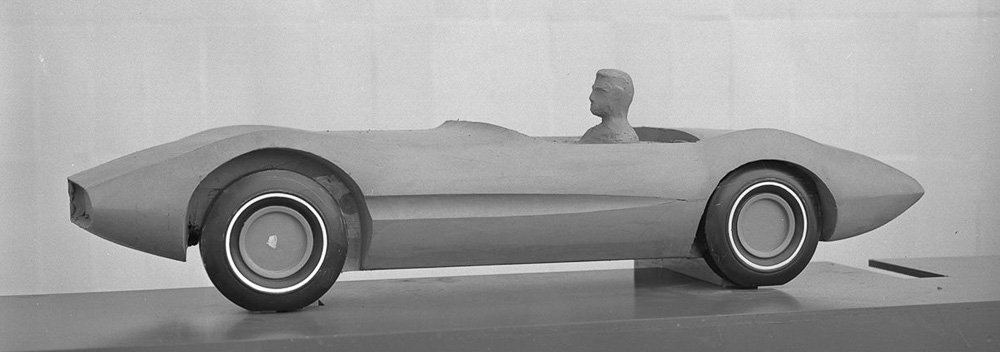
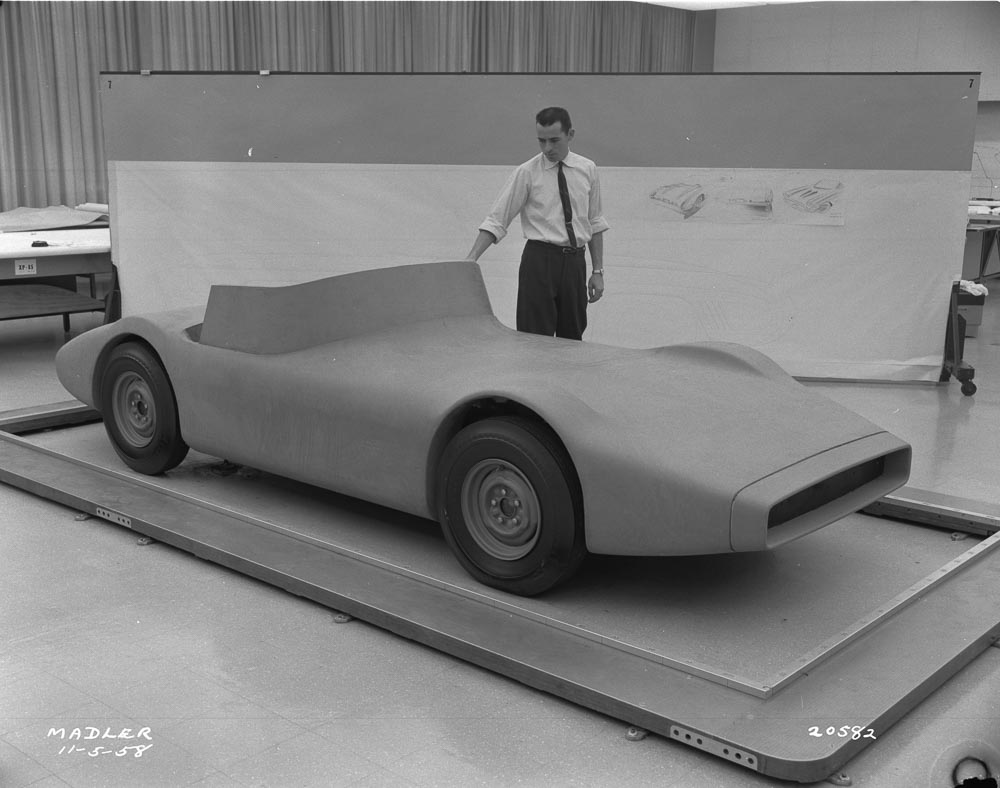
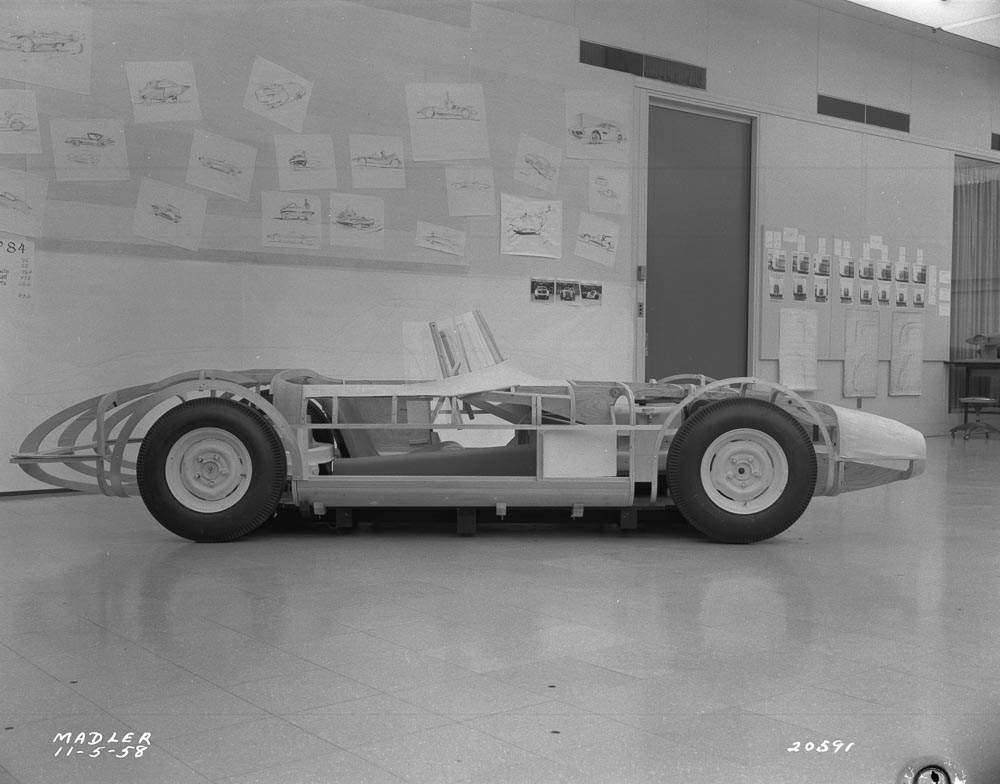
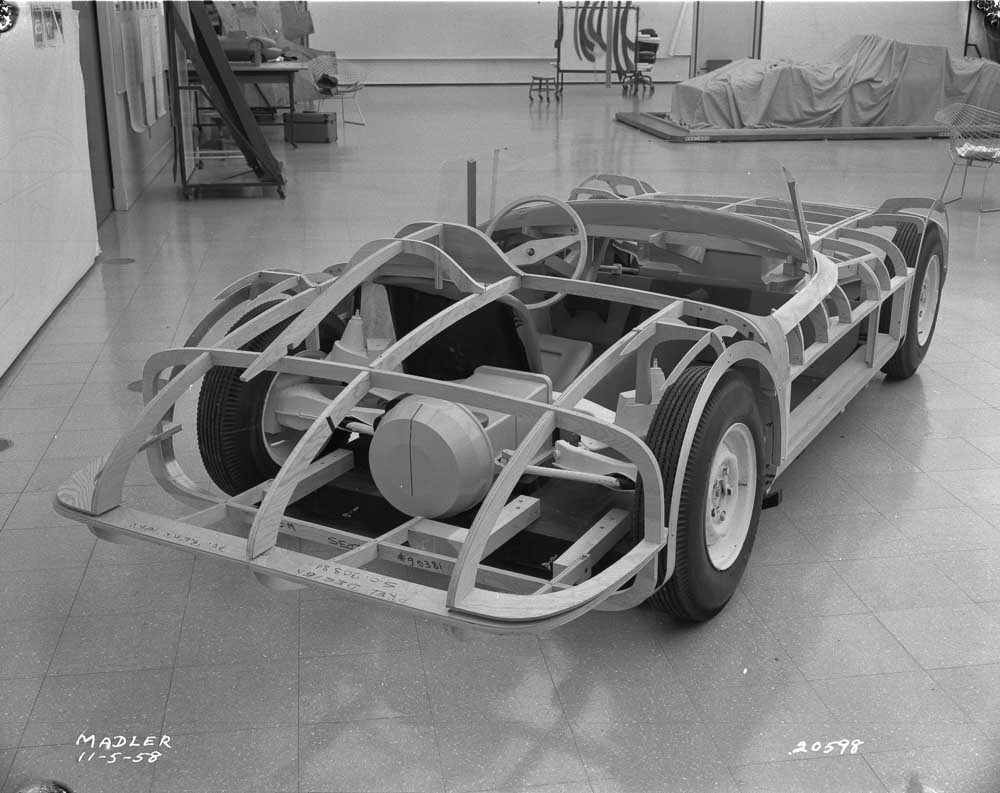
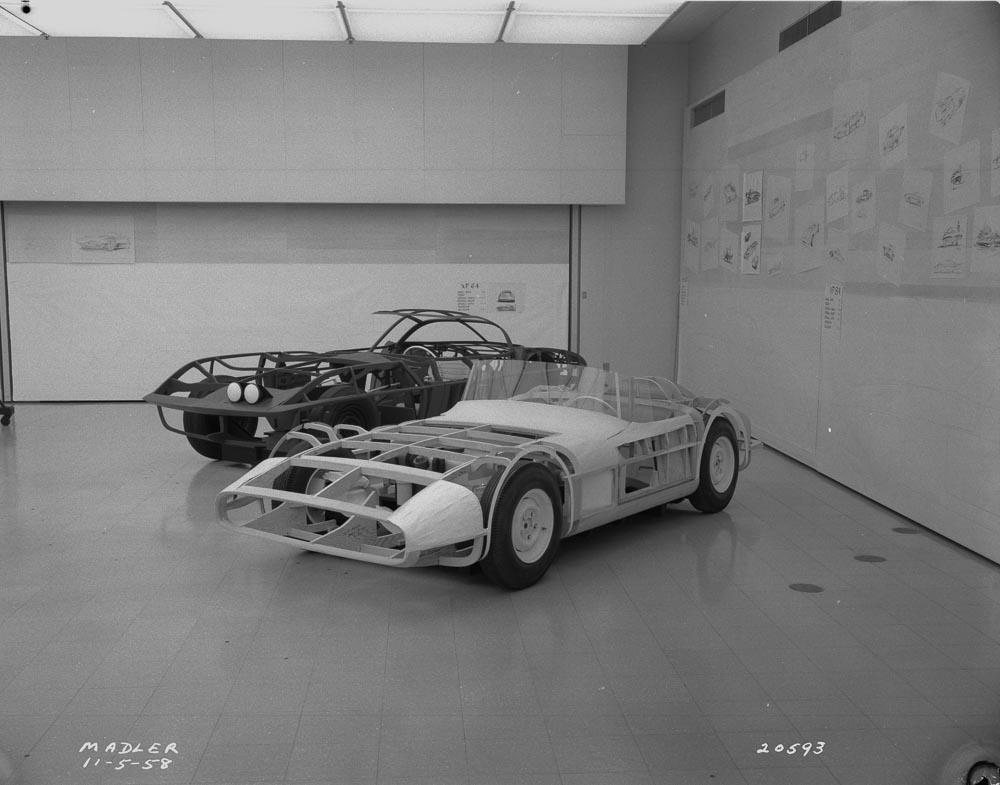
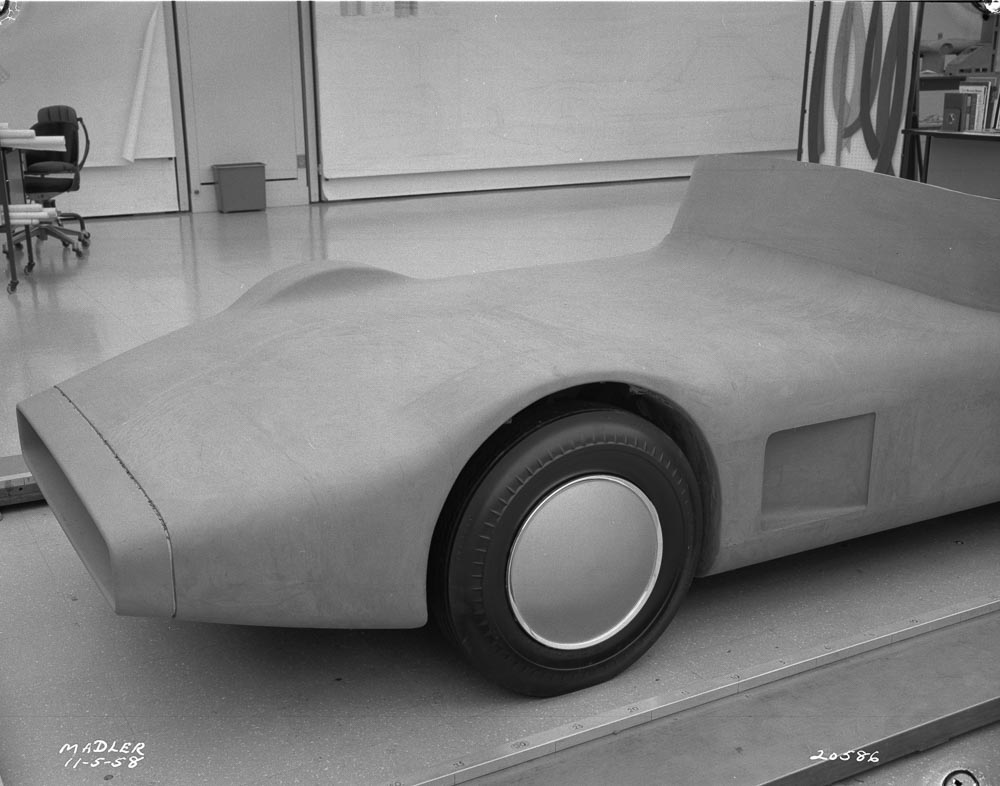
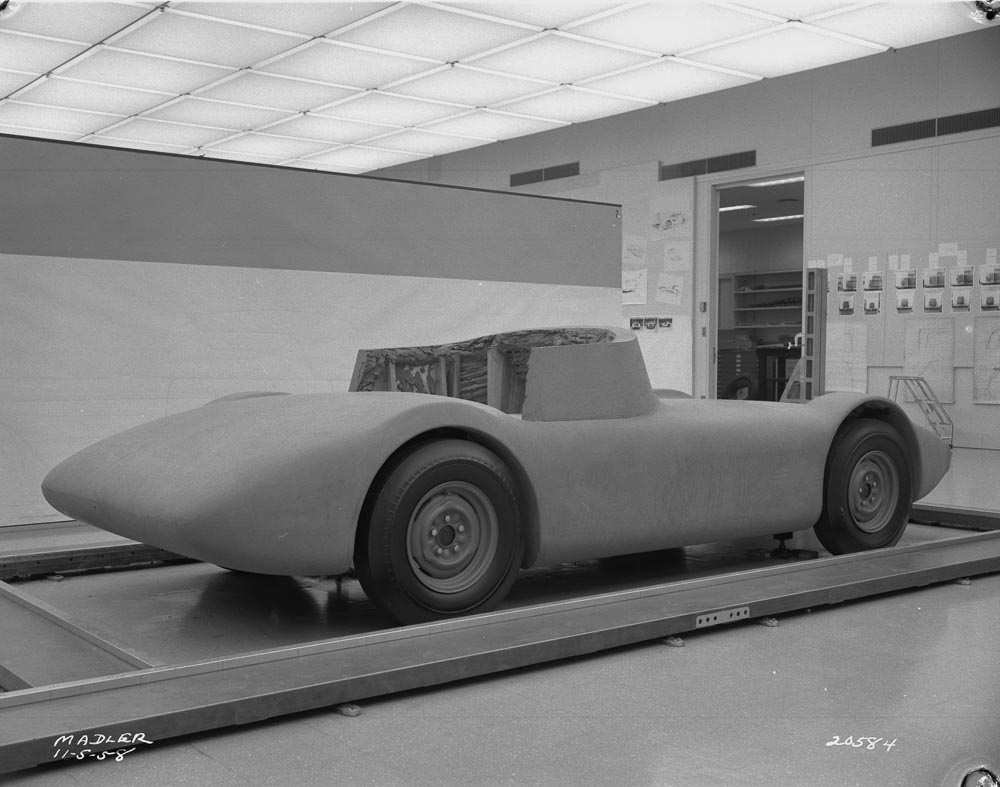
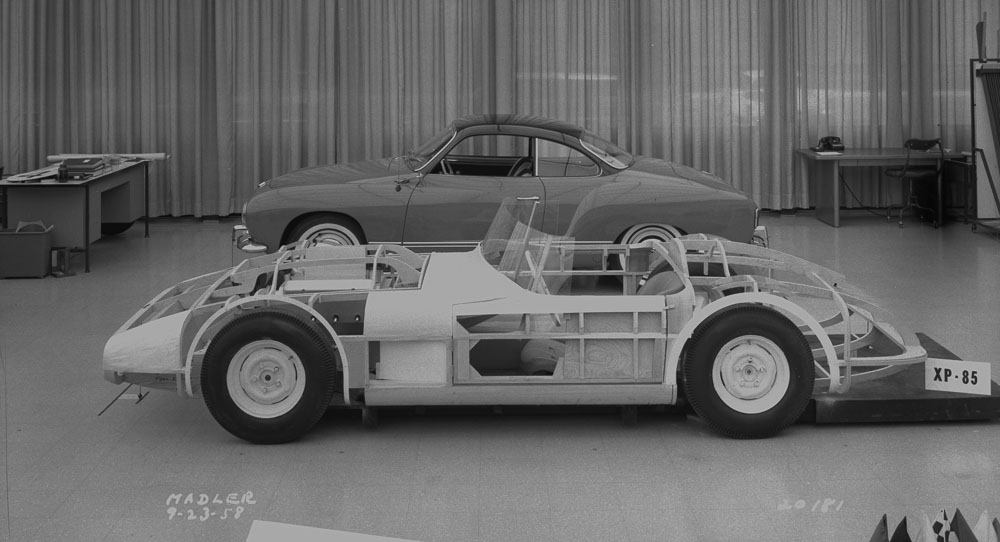
Interesting to read Peter’s story – very fortunate to find this piece of history in GM’s archives. Peter mentioned the probable V8 engine, but I noticed what appears to be a flat six engine mocked up in the body buck and sitting well below the bonnet line.
Wonderful to see Peter still writing. I’ve been a fan of his for years and worked with Peter at Wheels Magazine in the late 1990s.
CORVETTES ARE AMERICAN SPORTS CARS, POWERED BY AMERICAN DESIGNED AND BUILT ENGINES.
The unknown person in the first photograph could be Ron Roe who headed up the GM Styling Human Factors Group.
Ken Pickering
Photo 20598 seems to show a Tempest differential and rear suspension!
—I noticed that too. Sure looks like a transaxle.—Gary
It appears that there is a VW Karmann Ghia in the background of photo 20181. It has been said and written in other places that the inspiration for the Karmann Ghia was the Chrysler designed by Virgil Exner, Sr. If this Vette were to compete with the other cars mentioned it seems that it should have been smaller, i.e. on a shorter wheelbase. With the low hoodline a V-8 could have fit; consider the height of the hood on today’s Corvettes. Another engine option could have been the flat six engine that saw service in the Corvair. The transaxle could have been the one being designed and built for the Corvair, just turned around. This was done with some Corvairs that received 427 engines in the back seat. I am also surprised that we don’t see the Corvette windshield that was available at this time; had very pleasing lines.
Why would GM tap Holden for Corvette concepts? Doesn’t make sense to me. The only engine Holden were building here is Aus in that time frame was what we Aussies call the ‘Grey Motor’. It doesn’t add up to me.
The name Holden was camouflage for the rear engine Corvair product. Or the engine alone.
I agree with my friend Ken Pickering about the identity of Ron Roe in the picture. That was my first thought too.
Indeed the Corvair sailed under the ‘Holden’ code name…could this be a study intended to create a sports car for Holden to produce? Didn’t Joe Schemansky go down under to head Holden styling? He did the dash of the first Corvette…
In fifties, GM had a program for a transaxle transmission codenamed “Q project” which had to being used in the XP-87. In addition, with this flat and low bonnet, I bet on a Corvair’s engine.
In fifties, GM had a program for a transaxle transmission codenamed “Q project” which had to be used in the XP-87. In addition, with this flat and low bonnet, I bet on a Corvair’s engine.
The space buck in photo 20181 is sporting a prominent “hump” over the engine compartment,covering what appears to be a Chevy SB V-8 mockup (see valve cover), with what looks like possibly a tall F.I. intake doghouse.
I am a 35 year manufacturing veteran of GM Holdens ( Pt Melbourne) and retired in 2002.
I undertook a 2 year study and work assignment in the US, attending GM Institute (now Kettering University) and work experience at the Chevrolet Buffalo Gear and Axle plant from July 1969 to June 1970.
The Plant produced the Rear Axle assemblies for all Chevrolet A & B cars ( some 5000 per day!!) and in 1960/1970 was tooled up to produce, in addition, the Rear Axle assembly for the then new Chevrolet Vega.
Early Road Testing of preproduction cars indicated that the NVH in relation to the rear axle was NOT commercial.
The Chief Product Resident Engineer assigned from the Detroit Tech Centre was convinced that the monocoque vehicle construction (now called vehicle architecture) was the major reason for the excessive NVH, and he sought me out for a discussion as Holdens were producing monocoque vehicles and his information that we did not have a significant issues with NVH.
He stated that GM were only producing 2 monocoque cars namely the Chev Corvair and the Pontiac Tempest, but both had trans axles, with the Corvair being rear engined as well, and neither had no NVH issues with rear axle noise!!
In almost a throw away line he said that GM had built and experimental small Corvette with a Tempest Transaxle and a Holden engine, to run against the popular Austin Healy, and they selected the Holden engine because the Chev 6 cylinder engines were too big, too powerful and too heavy. The gentleman if still alive would be over 100!!
I never thought of this again until I read your article and when I looked closer at the photo on Page 15, it is clear that the “mock up” of the rear axle is in fact a transaxle!!
I found the attached article and photograph on the Internet and the transaxle has the flywheel/torque converter at the rear for easy changing ( like some early Ferraris) and the “mock up” resembles this feature.
Based on the design of the holding fixtures on top of the hoists I believe that this photo was taken in the GM Detroit Tech Centre or the Pontiac Tech Centre.
In the time frame based on lead times in the 50’s and 60’s it is not improbable that there were wooden “mock ups” of mechanical components as referred in the Internal Organization Letter, including a Tempest transaxle .
While we think they were referring to a “grey” motor, there would be “mock ups” of the “red” motor as the base design was conducted in the US and the motor was first built in Fishermen’s Bend 1963 ( pre production)
This snippet of info serves only to clarify the design concept slightly, and as you said there is probably no one alive that has an in depth knowledge.
In reality to the GM hierarchy this would be one of 100’s if not 1000’s of Projects that were just filed!!!
Graham Docker
Karl Ludvigsen is quite right: Joe Schemansky headed Holden design from 1964 until 1975. Joe was the first Holden design boss to control the new Holden R&D centre that opened in 1964. The local studio was then responsible for generations of Holden designs, starting with the HK (after the styling theme was set in Detroit) and highlighted by the 1971 HQ and the 2006 VE Commodore.
“Journalist Peter Robinson believes that the XP-85, a GM experimental project intended to create a sub-Corvette sports car, could have been designed around a Holden six-cylinder engine.”—Hemmings Blog
Clearly a Tempest transaxle. The torque converter hanging out in back and the design of the swing axles/control arms are very much the ’61-62 design.
One of the main reasons these GM Styling photos were so well-documented in the first place by the GM Photographic division was to establish a terrific paper trail. Harley Earl knew that! In this case, Holden’s down-under designers certainly wanted to build a sports car for the Australian marketplace, but the powers that be inside GM and GM Styling’s boss, HJE, had all the control to decide GM’s global designs and/or whether or not to actually create this sports car. Obviously, it never happened but that’s not what’s important here. We’re drawn in by another riveting factor that these historical photos demonstrate.
For example, it’s critical to show people something that doesn’t get much mention at all in auto & Corvette history. These historical photos clearly establish how the C2 Corvette – yes, the “Stingray” that wouldn’t be produced until the early 1960s – was created (simply look at the time-stamped date on all these pics) in the third and fourth quarter of 1958! That’s important because Harley hadn’t yet retired. One can get a new sense of how the second generation of Chevy’s modern sports car was created under HJE’s watch…and if anyone ever cared to find out about the “real Harley Earl” they’d realize that’s exactly what the proud papa of the Corvette would have done for his baby do before stepping down.
By the way, it’s nobody’s fault that this untold story hasn’t risen up sooner. After all, sometimes the truth remains buried, i.e., left on the back burner of time for decades. In this case, well over half a century! Traditional car designers and engineers following in HJE’s long shadow changed things around to suit their own purposes and agendas moving forward inside GM. After all, there would be no more men inside GM, after Harley Earl retired, who would ever create a halo car for GM anywhere near as iconic, powerful, and significant as the Corvette surely was/is. Why would men do this and/or slant the history their way, following in HJE’s footsteps? Human nature!
Think about this for a moment, it’s not like people aren’t known for this kind of behavior, right? Especially when you are talking about something as sexy and tied to the long-term success of Chevrolet as the Corvette. That’s how remarkable this one sports car was to GM before the end of the 1950s! Harley and the other mid-century dream team GM leaders who cemented this company near a fifty percent market share, by 1955, knew this! They also knew that when they handed the keys to their auto kingdom over to the next generation of leaders, these knew leading men of GM going into the 1960s, could and would, do whatever the hell they wanted to do! Guess what? That is exactly what GM’s new leaders went on to do…whatever they hell they wanted. It’s a big part of the freedom of living and working in America.
IMO, these facets of the story above don’t detract but instead enrich the long history of the Corvette legacy and wonderful heritage of General Motors.
Great story. GM needed but never had a mid-sized sports car to tamp down the market share (that’s what this is about, right?) that Austin Healey brought out: the above Sunbeam Alpine/below Jaguar price point. Of course, they didn’t do it, sadly.